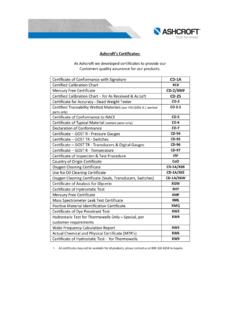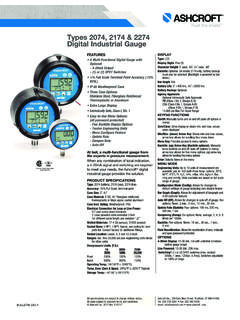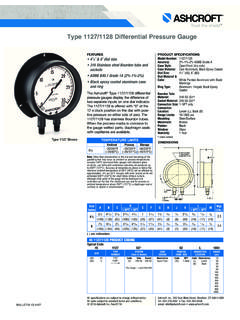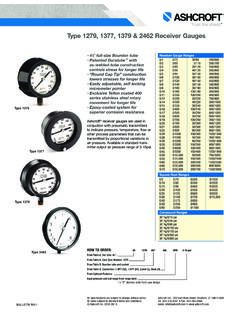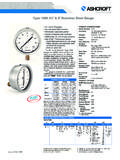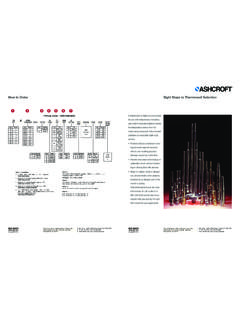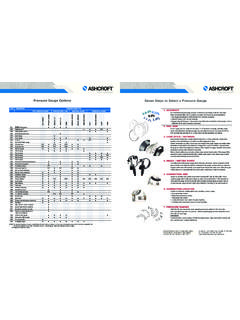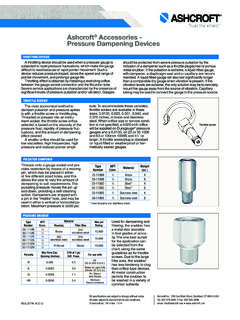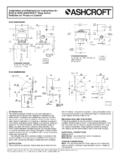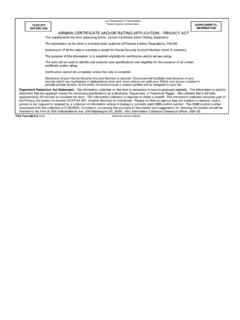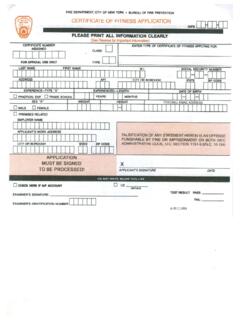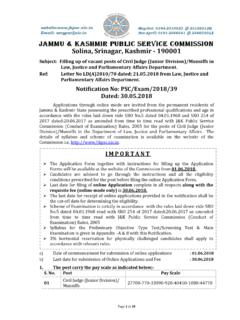Transcription of Installation and Maintenance Manual for the …
1 Installation andMaintenanceManual for theASHCROFT Type1305D DeadweightTester and Type1327D PortablePumpInstallation andMaintenanceManual for theASHCROFT Type1305D DeadweightTester and Type1327D PortablePumpI&M002-10095 4/02 (250-1526) Rev. 7 PURPOSE AND SCOPE OF MANUALThis Manual is provided to guide users of Model 1305 Dand 1327D pressure testing devices in:(1) installing the equipment(2) Routine operationsThe instructions in this Manual are designed to be per-formed by qualified instrument Maintenance Inc.
2 Does not recommend troubleshooting orrepairs beyond the scope of this Manual . Problems thatcannot be remedied by following the instructions in thismanual should be referred to the manufacturer. Immediateassistance can often be supplied by telephone. Defectivecomponents will be repaired or replaced by the manufac-turer at his discretion and will be returned to the user bythe same mode of shipment. Airmail or air express is rec-ommended for urgent shipments. Returned goods shouldbe accompanied by information requested in Section Customer Service at:Ashcroft East Main StreetStratford, CT 06614 Phone: (203) 378-8281 Fax: (203) : Safety PrecautionsPressure Testing Equipment must be selected and used inaccordance with recognized industry codes and safetypractices to avoid the possibility of misuse or misapplica-tion which could result in personal injury or property dam-age.
3 Personnel responsible for selection and installationshould also be familiar with the safety recommendations ofASME that apply to elastic pressure elements andtheir application in general and specific services. is available from:ANSIor ASME1430 Broadway345 47th StreetNew York, NY 10018 New York, NY 100171. Pressure Select a range so that the maximumapplied pressure will never exceed the upper range Vibration Excessive vibration could cause a loosen-ing of components and abnormal wear resulting in loss ofinstrument accuracy or failure to provide valid Temperature Operation of the instrument in an envi-ronment where temperatures are in excess of design rat-ings may result in loss of accuracy and Process Pressure boundary materials must be resis-tant to the process media.
4 Failure to assure compatibilitymay result in pressure boundary deterioration or operated at high pressure or with potentiallyhazardous service, such as oxygen, should be carefullyselected in accordance with recognized industry codesand the recommendations of ASME PRODUCT DESCRIPTION THEORY OF OPERATION CONSTRUCTION Product ConstructionThe Ashcroft Type 1305D Dual Range Deadweight testersare precision built primary pressure standards, used fortesting, setting, calibrating or repairing pressure measur-ing devices within the test points 15 psi (100kPa) to10,000 psi (70,000kPa).
5 Ashcroft Installation and Maintenance Manual for the Ashcroft Type 1305D Deadweight Tester andType 1327D Portable PumpINDEXS ection of Manual Safety Description 1305 Theory of OperationConstructionSpecificationsProdu ct Description 1327 Theory of Affecting Operation of Deadweight InstructionsList of IllustrationsFigure 1-1 Figure 1-2 Figure 2-1 Figure 2-2 Figure 5-1 The deadweight tester consists of a two stage hydraulicpump containing a manifold which is pressurized duringoperation. Integral to the pump is a shuttle valve thatallows the operator to regulate the speed of pressureincrease.
6 One connection to the manifold includes a cylin-der and a free-floating precision machined piston with aplate for holding calibrated weights. A second connectionto the manifold accommodates a gauge or other pressuremeasuring device to be calibrated or into the manifold is a hand operated dis-placement valve that allows small adjustments in fluid vol-ume to be made without further operation of the pumphandle or release tester is dual range having two interchangeable pistonandcylinder assemblies. One is a low pressure pistonhaving an effective area five times larger than that of thehigh pressure piston.
7 The low pressure piston is used formaking measurements below 2,000 psi (14,000 kPa). Thehigh pressure piston, with an area 1/5 that of the low pres-sure piston, is used to measure pressure through 10,000psi (70,000 kPa). The weight masses are pre-measuredand identified with the pressure values they produce whenoperated with the interchangeable piston and calibration points produced by the deadweighttester are accurate to within of the reading certifiedtraceable to the The tester provides consistent,repeatable accuracy, maintaining its pressure for an appre-ciable length of time regardless of temperature changes,slight leaks in the pressure system.
8 Or changes in volumeof the pressurized system due to movement of a Bourdontube or other hand jack set, three wrenches, spare O-rings, and aspecial adapter for making connections to pressure outletsthat do not accommodate cone pipe seating, are includedwith each deadweight testers are supplied with lower and backconnection offset pipe assemblies, with pipe adapters for 1 4 NPT or 1 2 NPT all metal, double-latched, top handle carrying case issupplied with the complete tester for all fittings and attach-ments.
9 Deadweights are packed in metal, double-latchedstorage-carrying Theory of Operation 1305 DThe theory behind a deadweight tester can be expressedas simply as force acting upon a known area. Pressureproduced by the pump is distributed by the manifold, to thebase of a precision machined piston and to a device beingcalibrated or checked. Pre-selected weights loaded ontothe piston platform are acted upon by gravity and developa force that is to be equally opposed by the fluid pressurefrom the pump. When equilibrium is achieved, the pres-sure value is known, it being a direct result of the sum ofthe forces from the weights, piston platform and the pistondivided by the effective area of the piston and the 1305D two piston and cylinder assemblies aresupplied, one having an effective area 1/5 of the using the smaller piston and cylinder assembly, fivetimes more pressure is required to oppose the force of aconstant mass being acted upon by gravity.
10 For this rea-son the masses supplied with the tester are stamped withtwo pressure values, the value being contingent on theeffective area of the piston and cylinder assembly Specifications 1305 DAccuracy:Combined tolerance of weights and piston andcylinder assemblies within of reading. Weight toler-ance within of mass. Piston and cylinder is of rated mean effective :Non-magnetic die cast zinc alloy. Totalweight to produce maximum pressure of 10,000 psi(70,000kPa) is 125 lbs. ( kg).Piston & Cylinder Assemblies:High strength stainlesssteel piston and cylinder with brass collar and aluminumweight :Two stage, lever operated generates 10,000 psi(70,000 kPa) with 28 pounds ( kg) of force on Body:Aluminum, corrosion inhibited and coatedwith baked blue epoxy Valve:Stainless steel bypass valve that controlsrate of pressure increase and reduces operator effortwhen working at high Valve.
